Notes
Kill Them with Kindness: Leading up to the Lie Maduro Burned US Aid Trucks
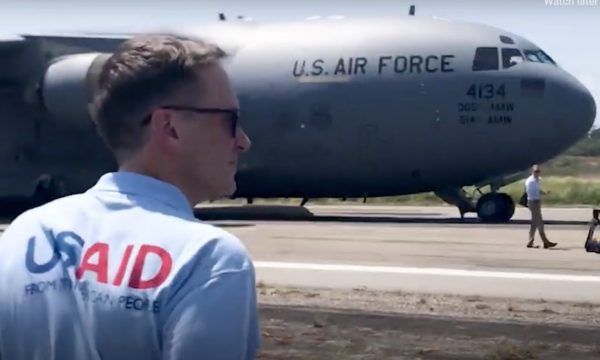
For President Trump’s political base, what happened on February 23rd was as outrageous as it was cut-and-dried. According to Washington, soldiers of the embattled Venezuelan dictator, Nicholas Maduro, not only blocked humanitarian aid trucks from crossing a bridge between his country and Columbia to deliver necessary supplies to his desperate citizens, the soldiers set fire to them as protesters and the visual media looked on.
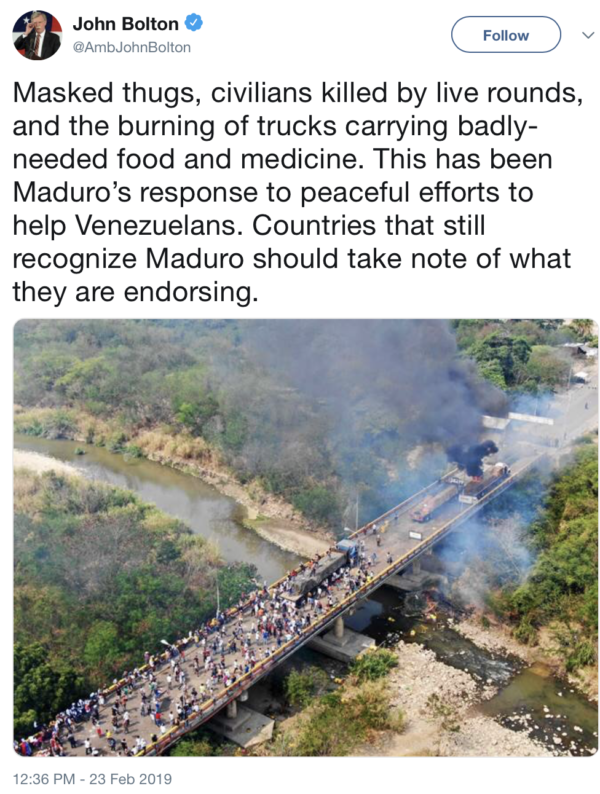
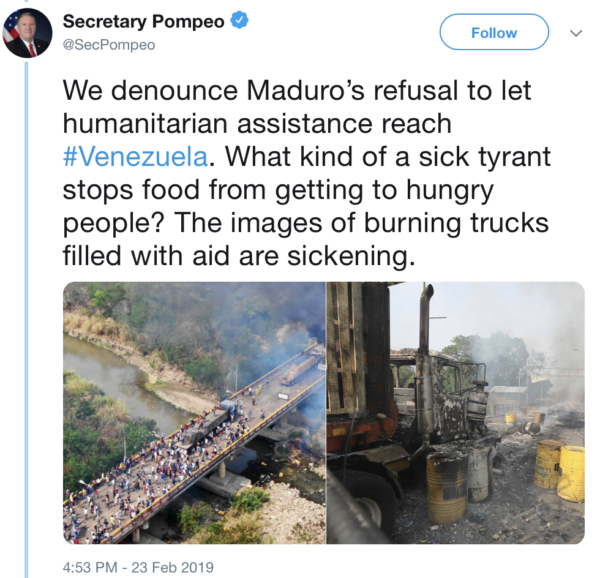
At least that’s what you are lead to believe. At remarkable speed, and well within the news cycle, the secretary of state and the national security advisor, as well as Florida Senator Marco Rubio, were denouncing this egregious act, touting images to verify its inhumanity.
There were certainly independent media sources to challenge that conclusion. An article in Mint Press said that a Molotov cocktail, tossed by an anti-Maduro protester alongside the row of trucks had actually started the fire. Another article from the independent journalism site, Venezuelanalysis, reached a similar conclusion. And finally, a comprehensive reconstruction by the New York Times visual investigations team seems to prove conclusively that this is what happened.
What is missing from the bridge story, however, is the role the United States and USAID played in stoking this incident in the first place. Based on still further visual analysis, encompassing social media and the weight of readily available news photography, it is clear to see how the US administration used the humanitarian aid as both propaganda, and as a vehicle to try and shame Maduro. And finally, on February 23rd, it backfired.
What was coming could not have been more clear, culminating on the 22nd when pro- and anti-Maduro concerts were held on opposite sides of the barricaded Tienditas International Bridge. On the Columbian side, industrialist Richard Branson hosted several thousand people for one of the concerts, including Latin American leaders and the newly arrived American lighting rod, Elliott Abrams. The stated intent was to move supplies the next day across the Francisco de Paula Santander bridge to confront the Venezuelan troops blocking the other side.
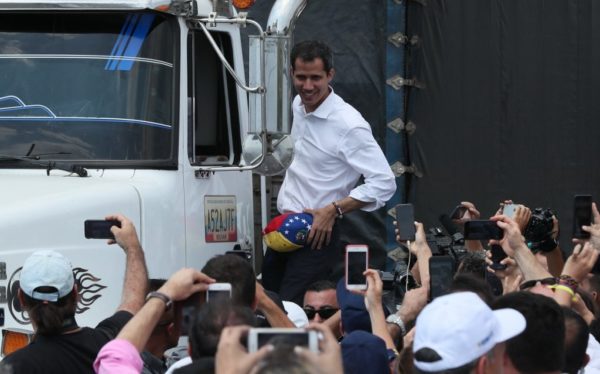
Parliament President and self-appointed interim president of Venezuela, Juan Guaido, was part of the strong arm maneuver, as you can see in this photo from EPA. Heightening the tension (and visually branding the provocation in his name), Guaido posed for photos on the running board of one of the aid 14 trucks filled with 280 tons of humanitarian aid departed from Cucuta on the Columbian side.
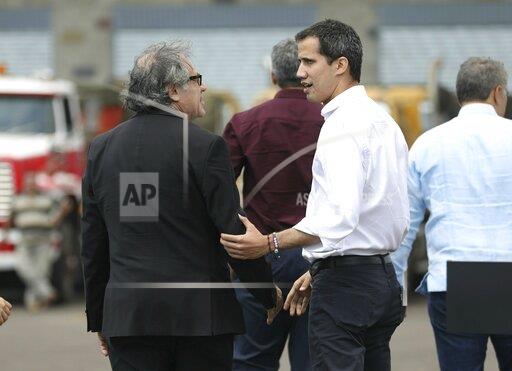
Largely an American operation, in this AP photograph we see Guido at the USAID warehouse that morning alongside the Secretary General of the OAS.
No one on the American side was more active in the campaign, however, than Marco Rubio. Rubio’s role in the standoff, and the crisis in Venezuela, overall, has been vicious. Taking on the attack dog role, Rubio has been agitating incessantly about Venezuela’s “evil regime” in personal visits and especially over social media. On the 23rd, Rubio was not only aware of the provocation, he was practically live tweeting it in the most triggered (“Here we go”; “Please pray”) and agitating terms.


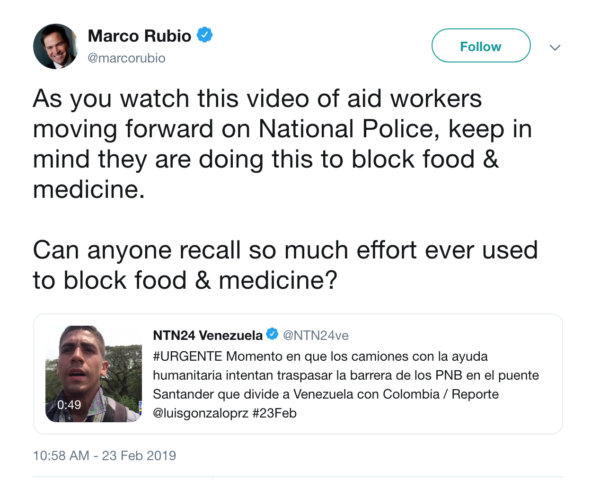
The most heavy-handed social media, however, came from the head of USAID, Mark Green. If you haven’t been following the political weaponizing of the American aid agency, just tracking Green’s social media activity in the weeks leading up to the bridge incident (that’s Green in a screen shot from an USAID video leading the post) illuminates how much the American government’s relief arm now serves as the tip of the spear.
In April of 2017, Foreign Policy lamented “The End of Foreign Aid As We Know It.” Merging the USAID program into the State Department had effectively blurred development assistance with the administration’s national security objectives. In the aftermath of the bridge fire, under a photo of Guaido on the running board, senior policy fellow at the Center for Global Development, Jeremy Konyndyk, outlined a series of steps to help the Venezuelans. One of the key points: depoliticize the delivery of aid. Most reputable international organizations, including both the Red Cross and Caritas, the humanitarian arm of the Catholic Church, have refused to get in the middle of this aid charade. The Red Cross told CNN that the initiative organized by the Venezuelan opposition is too political.
Mark Green, the head of USAID, used the bridge standoff as a political wedge for almost two weeks, using social media as a tool to disseminate photos of the staples in the American warehouse and also the inability to move it over the bridge. This built to a crescendo, Green himself sending increasingly provocative tweets, including five on the 22nd, and seven on the 23rd.
This one is the most pointed, with USAID personnel posing staring across the bridge, the tweet addressing Venezuelan security forces in the tone of an ultimatum.
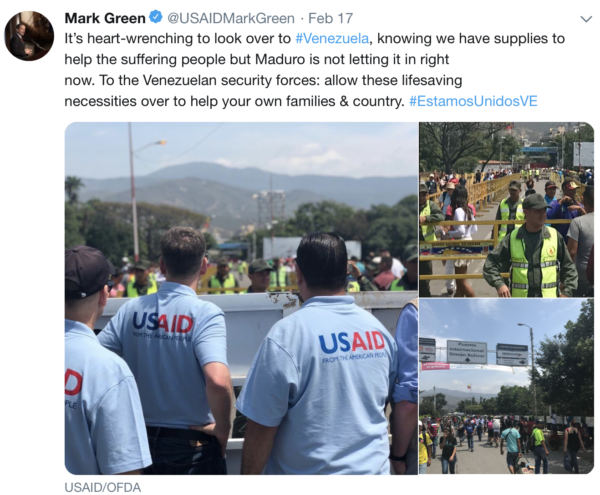
Here is Green retweeting Marco Rubio in the US warehouse on the 17th, practically dangling large aid packages in Maduro’s face.
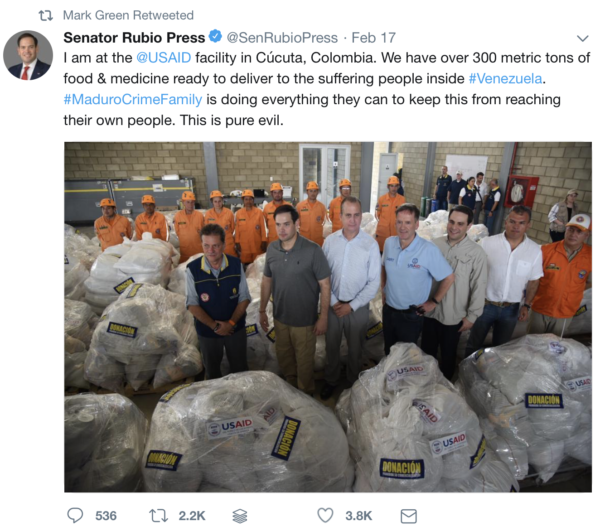
Here’s another shot from the warehouse with Rubio on the 17th, the Americans riffling though desperately needed hygiene kits and medical supplies.
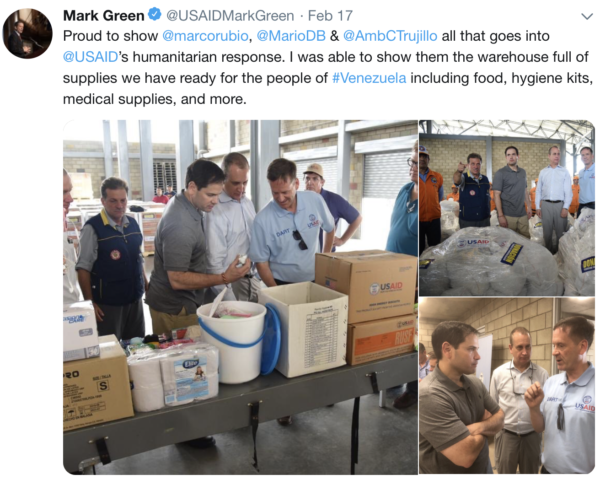
This photo of an aid transport is an ominous telegraph. As a parallel to Trump sending troops to the US/Mexico border, the prominent display of an Air Force transport speaks to the bellicose nature of the aid mission and the US flexing its muscle.
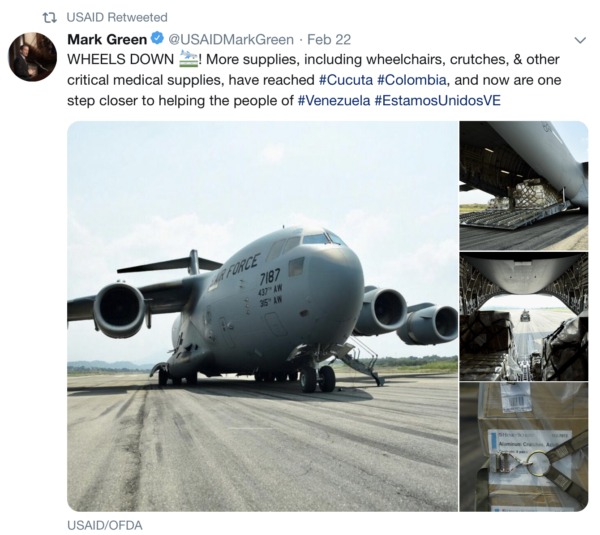
And here is Abrams on the scene the day before, the man a walking red light in the southern hemisphere. Assigned by Trump as special envoy to Venezuela, the toxic Abrams is famed for his role in the Iran-Contra scandal, his links to Salvadoran death squads in the early 80’s, and the failed Venezuelan coup in 2002.
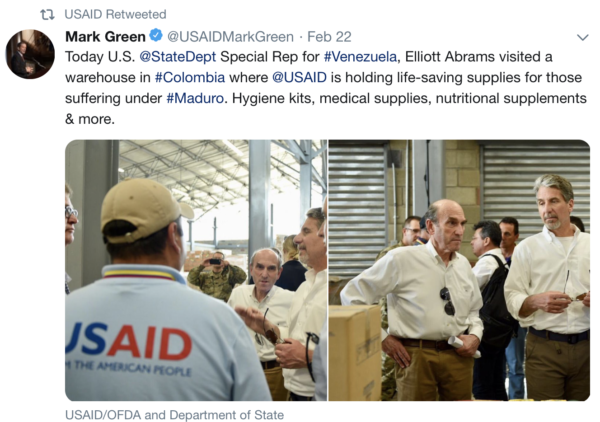
Here we see Green tweet-trumpeting the start of the convoy, the date tagged as a “humanitarian avalanche.”
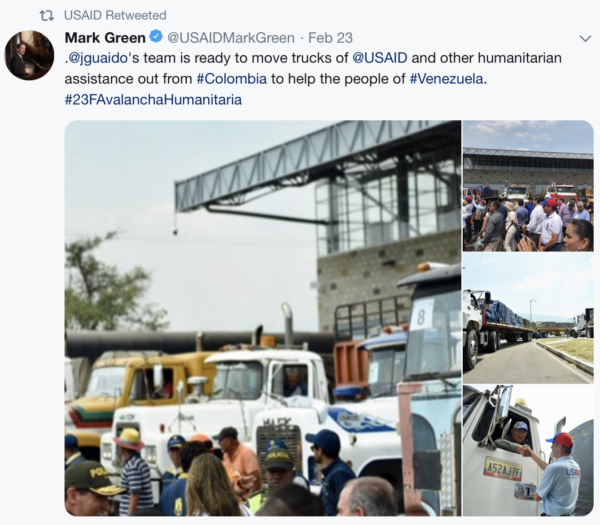
And finally, some hours later, Green retweets Bolton, also pinning the burning on Maduro.
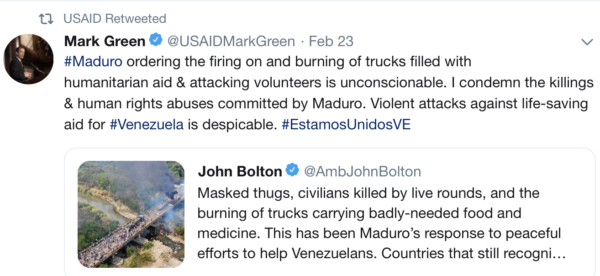
In the aftermath, this tweet reads like a tribute to the brave, but the prominence of the box serves as much as a martyr-like branding opportunity.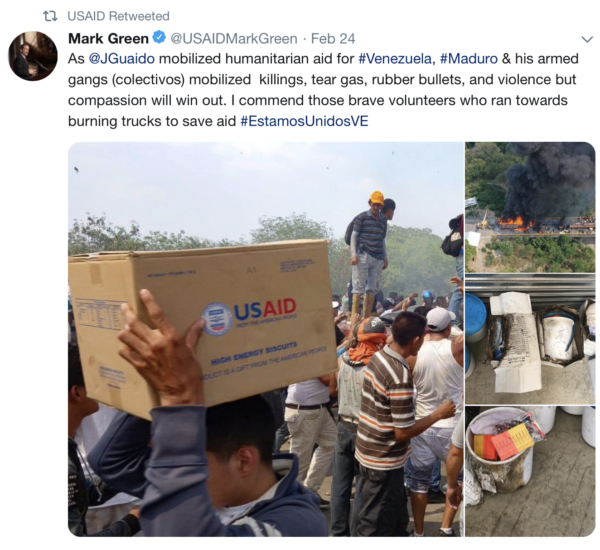
The other evidence of the manipulation comes from US media photos. Those images document the heavy handed propaganda mission with the aid supplies used as bait. Take these photos from this February 21 press conference, for example.
As we’ve seen in other instances during the Trump administration, relief items are laid out on tables as both media exhibits and moral indictment.
In retrospect, the incineration of these aid trucks was not surprising nor was it mysterious. Instead, what happened was almost an inevitable outcome of a disingenuous American aid operation spoiling for a fight. In this case, Maduro had every right to call out the American’s so-called humanitarian mission as a setup. The aim of USAID mission, as reflected so clearly for weeks, was literally to “kill him with kindness.”
Photo 1: Screenshot from USAID video on Venezuelan aid mission, February 2019. Photo 2: Mauricio Duenas Castaneda/EPA-EFE Caption: Venezuelan Parliament President Juan Guaido greets people from a truck in Cucuta, Colombia, 23 February 2019. Guaido called today to the Venezuelan Armed Forces to put on the ‘right side of history’ and allow the entry of the 14 trucks that departed from Cucuta with 280 tons of humanitarian aid. Photo 3: AP Photo/Fernando Caption: Vergara Venezuela’s self-proclaimed interim president Juan Guaido, right, speaks with OAS Secretary General Luis Almagro, outside the warehouse housing U.S. humanitarian aid destined for Venezuela, in Cucuta, Colombia, Saturday, Feb. 23, 2019.

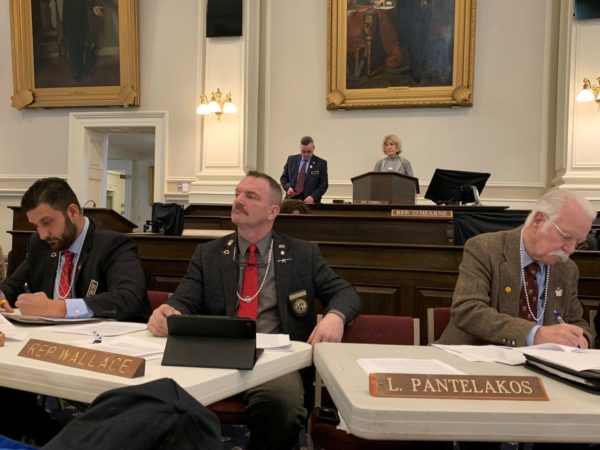
Reactions
Comments Powered by Disqus